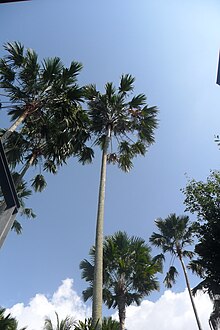Loading AI tools
Species of palm From Wikipedia, the free encyclopedia
Saribus rotundifolius, also known as the footstool palm,[2][4][5] is a common fan palm found in Southeast Asia.[6] It is a member of the genus Saribus.[5][7]
| Saribus rotundifolius | |
|---|---|
 | |
| Saribus rotundifolius at the Nong Nooch Tropical Garden, Thailand | |
| Scientific classification | |
| Kingdom: | Plantae |
| Clade: | Tracheophytes |
| Clade: | Angiosperms |
| Clade: | Monocots |
| Clade: | Commelinids |
| Order: | Arecales |
| Family: | Arecaceae |
| Tribe: | Trachycarpeae |
| Genus: | Saribus |
| Species: | S. rotundifolius |
| Binomial name | |
| Saribus rotundifolius | |
| Synonyms[2][3] | |
It is called anáhaw or luyong in Filipino.[4] In Malay the palm is known as serdang daun bulat.[2]
Saribus rotundifolius was first described as Corypha rotundifolia by the French Jean-Baptiste Lamarck in 1786.[8] It was moved to the Saribus genus by the German-Dutch botanist Carl Ludwig Blume in a publication issued in 1838 or 1839.[1] This move was generally not accepted by others in the field. In 2011, after DNA research, the reclassification from the Livistona genus to the resurrected genus Saribus was official.[7][9] The generic epithet Saribus comes from a local name in one of the Maluku languages, as recorded by the Dutch, sariboe.[10] The specific epithet means 'round-leaved' in Latin.[9]
Saribus rotundifolius is a hermaphrodite fan palm.[2] The palm is evergreen, erect, and only grows having a single trunk ('solitary'). It grows at a height ranging from 15 to 25 metres,[11] exceptionally up to 45 metres tall,[2] and thickness of 15 to 25 cm diameter at breast height.[2][11] Its trunk is smooth and straight with a shallow rings of leaf scars.[11] The trunk is rather massive and tapering. It usually grows to 60 feet (18 m) tall, but may rarely reach 90 feet (27 m) tall. The young trees have a green crown. This species is seldom seen with a slight skirt of drooping, dead leaves. The sheaths are chestnut brown in colour.[9]
The palmately-lobed leaves are spirally arranged around the trunk. The petioles are long.[9][10] The entire leaf is some 1.2 metres in length. The leaf blade is entire in its centre,[9] and almost round in outline. It is regularly divided to about half of the length and 1.2 metres in diameter.[10] The leaf segments are forked, but not deeply, at their ends.[9] The leaf segments have one main nerve.[12]
The flowers are borne on an inflorescence with a long peduncle, about 0.9 to 1.2 metres long. The three-petalled flowers appear in bunches.[10]
The fruit is a fleshy drupe.[10] It is about 2cm in diameter,[9][10] quite round,[9] and coloured brick red as it ripens, ultimately becoming black when ripe.[9][10]
The palm is native to Sulawesi and the Maluku Islands in Indonesia, and the Philippines. The native distribution stretches from Banggi Island in Sabah, Malaysia, off the north-east coastal tip of Borneo in the west, to the Raja Ampat Islands near Maluku off the north-west tip of Bird's Head Peninsula in Indonesia's West Papua province in the east. Its northernmost native distribution is in the Philippines.[3][5] It is abundant throughout the Philippines.[5] It has been introduced into the wild in Java, the Lesser Sunda islands, Peninsular Malaysia and Trinidad and Tobago.[3] It has also been introduced to India.[10]
On Java it occurs in the west and the central-eastern parts of the island. It is usually found as a cultivated plant, but already in the 1960s in some places it has escaped into the wild, becoming locally very numerous.[12]
The lepidopteran caterpillars of the species Suastus gremius and Elymnias hypermnestra have been recorded using Saribus rotundifolius as a host plant.[13] The tree only flowers after it becomes very old. Its flowers are pollinated by bees.[10]
Saribus rotundifolius can be grown in humid, tropical areas. It is a common landscaping plant in the Philippines, and has been widely cultivated in Peninsular Malaysia, Singapore, Java and elsewhere, for a long time.[7][9][12] The fruit are quite attractive.[10] It is cultivated as an ornamental throughout Colombia.[3]
The leaves are used for the thatching of roofs and wrapping food. Overharvesting of the leaves of plants causes a reduction in leaf size. The leaves do grow faster after harvest but tend to be smaller.[6]
The foliage of the Saribus rotundifolius is the unofficial national leaf of the Philippines.[14]
This plant species is common and has been classed as 'least concern'.[5]
Seamless Wikipedia browsing. On steroids.
Every time you click a link to Wikipedia, Wiktionary or Wikiquote in your browser's search results, it will show the modern Wikiwand interface.
Wikiwand extension is a five stars, simple, with minimum permission required to keep your browsing private, safe and transparent.